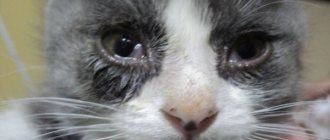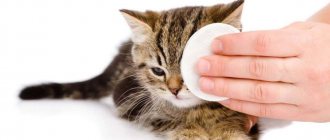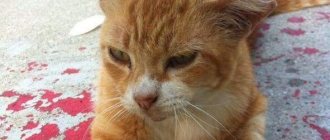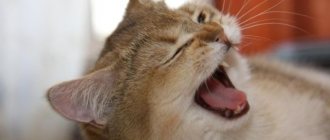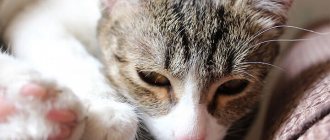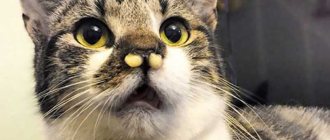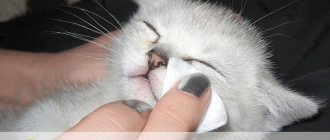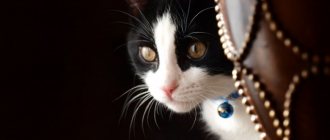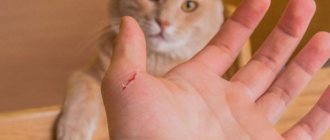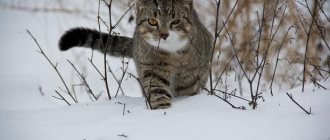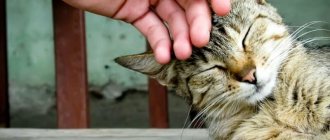9569Administration
All cats sneeze from time to time and, I must admit, it looks pretty funny. However, if a kitten is sneezing and its eyes are watery, this combination of symptoms should cause concern rather than a smile in its owner.
The causes of sneezing in a kitten can be different. The most common are:
- Various infectious diseases;
- Allergic reaction to any irritant;
- Injury or foreign bodies in the nose
It can be extremely difficult to independently determine the exact causes of a pet’s illness and can only be done by a specialist.
© shutterstock
Therefore, if your kitten begins to sneeze very often and his eyes are very watery, it is better to immediately contact a veterinarian.
There are situations in which it is impossible to get immediate qualified help. In this case, you can try to alleviate your pet’s condition by using our advice.
Features of symptoms
Sneezing is not the only symptom indicating that your pet is unwell. Depending on the cause and degree of neglect of the disease, the following clinical manifestations develop:
- eyes are swollen, lacrimation is small, moderate;
- the hair around the eyes falls out, eczema and dermatitis develop;
- the consistency of the discharge changes;
- the animal rubs its head on various objects due to itching;
- dry discharge in the corners of the eyes;
- redness, swelling of the conjunctiva;
- fear of light.
If your pet is constantly sneezing and the tearing does not go away, you need the help of a veterinarian. The doctor will tell you what to do to eliminate the symptoms after an accurate diagnosis is made.
Allergic reaction
With reduced immunity, a cat may experience increased sensitivity to certain substances. This could be new food, natural products, tray filler, medications, volatile compounds. The body's response to the irritant is expressed in the form of allergic conjunctivitis. The cat's eyes become watery, the edge of the eyelids or eyeball turns red, and swelling appears. Sometimes there are accompanying behavioral symptoms: lethargy, apathy, loss of appetite. The animal may sneeze.
If the tear secretion is clean, without questionable inclusions, then the allergy is treated with antihistamines. But the main thing in such a situation is to identify the allergen and eliminate it from the life of your furry pet. Otherwise, it will be difficult to solve the tear problem with treatment alone.
Possible reasons
One of the most common reasons for the development of such symptoms is an allergic reaction. Irritants can be:
- household chemicals;
- tobacco smoke;
- fungus on tiles and other surfaces;
- perfume, hairspray, nail polish;
- sprays used in the fight against flies, mosquitoes, and other insects;
- dust;
- cat litter;
- plant pollen.
Tearfulness accompanied by sneezing occurs due to other reasons:
- foreign body in the eye;
- injury;
- failure to comply with pet care rules;
- features of the anatomical structure of the organs of vision;
- various pathologies;
- infections.
Possible diseases
You can tell that a kitten is sick by looking at its condition. The animal's behavior changes dramatically, the pet becomes lethargic and passive.
The reason for this may be:
- colds (runny nose leads to sneezing, watery eyes);
- asthma;
- rhinitis;
- conjunctivitis;
- helminthic infestation;
- neoplasms, polyps;
- pathology of teeth, gums;
- immunodeficiency;
- rhinotracheitis;
- malignant processes.
Infectious causes
The cause of the deterioration of the cat’s condition may be an infectious disease that must be identified promptly, because a sick animal can infect other pets.
Pathologies that cause sneezing and tearing:
- Herpesvirus (infectious rhinotracheitis). Against the background of the disease, there is a risk of developing ophthalmological problems. The pet's condition can rapidly deteriorate.
- Mycoplasmosis, chlamydia. Treatment of these diseases begins immediately after diagnosis.
Causes of sneezing and tearing in one eye
Among the reasons why a cat sneezes, but only one eye is watering, are the following:
- eye injuries;
- ingress of smoke, chemicals, caustic vapors;
- narrowing of the tear duct;
- entropion of the eyelid;
- helminthic infestation;
- congenital ocular abnormalities;
- conjunctivitis.
External factors of tearing eyes
In addition to internal reasons associated with diseases and features of the anatomical structure of the visual analyzer, there are external factors that increase tear production. Conventionally, they can be divided into two groups. The first is foreign objects trapped under the eyelid. A cat cannot always remove specks, dust, and dirt on its own. Sharp objects can mechanically injure the eye. If foreign particles linger on the mucous membrane, they cause itching, redness, and inflammation. Increased tear production in such a situation is a physiological reaction of the body. The liquid helps to wash out foreign matter.
The second group of irritants does not reach the mucous membrane directly. Tear secretion begins under the influence of volatile compounds contained in the air. The reason may be the aromatization of the room, chopping onions, the release of an increased amount of natural gas, smoke from cigarettes or a fire. There is no need to treat the cat, just rinse the eyes with saline solution.
Associated symptoms
Deterioration of the condition is accompanied by the following symptoms:
- hot nose;
- temperature increase;
- apathy;
- weakness;
- loss of appetite;
- sometimes blood comes from the nose;
- a sharp decrease in body weight;
- ulcerations, skin rash;
- purulent discharge from the eyes, nasal passages;
- breathing is accompanied by whistling, wheezing;
- cough;
- gagging;
- diarrhea.
These signs indicate the development of a serious illness. Immediate veterinary assistance is needed.
What to do if your cat is sneezing and her eyes are watering
The best thing an owner can do if their cat or kitten is sneezing and their eyes are watering is to take their pet to the vet as soon as possible. Self-medication can significantly worsen the animal’s condition, because no owner can make a correct diagnosis without special diagnostics and laboratory tests. In addition, some cat diseases can be transmitted to humans.
Dangerous accompanying symptoms
If the following alarming symptoms appear in a constantly sneezing pet, you should urgently take him to the veterinarian:
- Excessive swelling of the oral mucosa, which makes breathing significantly more difficult.
- Bloody discharge from the nose.
- Vomiting and diarrhea.
- Change in eye color, clouding.
- Excessive weight loss.
- Ulcers and other skin rashes.
- Copious discharge of pus from the nose, ears and eyes.
- Too lethargic or, conversely, an excited state.
- Prolonged fever.
- Constant watery eyes, itching and irritation in the eye area.
Important! If a cat picked up on the street sneezes and has snot, you should also show it to a doctor to avoid infecting other pets in the house.
Diagnostic methods
At home, it is difficult to determine the exact cause of the cat’s deterioration. You need to seek help from a veterinarian . During the diagnosis, the animal is examined, body temperature is measured, and an anamnesis is collected by interviewing the cat's owner.
The following studies are prescribed:
- general and biochemical blood test;
- Analysis of urine;
- taking swabs from the nasal cavity and throat;
- nasal endoscopy;
- X-ray of the head.
Cat Eye Care: Preventing Tears
In order not to have to find out the reason why your cat’s eyes are watery and not resort to treatment, it is necessary to constantly engage in the prevention of eye diseases. This is especially true for purebred kittens that have a genetic predisposition.
If your cat’s eyes water for natural reasons, then for hygienic care it is enough to periodically wash them with a physiological or disinfectant solution. In case of abundant natural discharge, the procedure is carried out twice a day: in the morning and in the evening. This hygienic treatment is suitable for the prevention of eye diseases in cats of all breeds.
The complex of preventive measures includes systematic treatment against helminths and ectoparasites. To prevent a long-haired cat from having watery eyes, she needs grooming. Long hairs can touch the eyeball and stimulate tearing. To exclude chronic diseases and infections that provoke eye diseases, the pet should be protected from hypothermia, vaccinated on time and fed with nutritious food.
All accessories and tools for processing (swabs, pipettes, syringes, containers) must be perfectly clean.
How to help a sick animal at home
It is impossible to treat a cat without knowing the cause of the pathology. Need specialist advice.
Conditions favorable for the sick animal are created at home:
- contact with potential allergens is excluded;
- drafts and other negative factors are eliminated;
- Wet cleaning is carried out in the room;
- pet care rules are followed.
The best solution is to immediately consult a doctor. But there are situations when there is no veterinarian nearby.
Remedies that can help in this case:
- Furacilin (used for washing the organs of vision for conjunctivitis);
- an aqueous solution of Levomycetin (helps eliminate bacterial conjunctivitis, the product is instilled into both eyes);
- antibiotic-based ointments;
- solution of Novocaine, Hydrocortisone (eliminates pain, used as injections);
- Hormonal drugs are indicated in case of the development of a severe allergic reaction.
Drug therapy
Therapy is aimed at eliminating the causes of the painful condition. The following groups of drugs are prescribed:
- antibiotics;
- antiallergic drugs;
- antiviral drugs.
Measures are being taken to strengthen the immune system.
The following drugs are prescribed:
- Anandin . It has a wound-healing, antiphlogistic effect, relieving inflammation.
- Maxidin . Characterized by an immunostimulating effect. Helps activate the body's protective functions.
- Thymogen . It has an immunomodulatory effect similar to Maxidin.
If these drugs are ineffective, then resort to the use of strong drugs, including:
- Naphthyzin. Has an anti-inflammatory, vasoconstrictor effect.
- Dioxidine. The drug has an antiseptic effect and is used for the development of purulent rhinitis.
- Derinat. Immunomodulatory agent that activates defenses. Helps cope with conjunctivitis and rhinitis.
- Nazivin. Has a vasoconstrictor effect. It is used to identify inflammatory processes in the respiratory and vision organs.
- Galazolin. Used to treat otitis and rhinitis.
Severe forms of pathologies are treated with the following medications:
- Diamond eyes;
- Furacilin;
- Iris;
- Tsiprovet;
- preparations based on Levomycetin.
Application of traditional medicine methods
Folk remedies are not used as the main treatment. Decoctions and infusions are used in combination with drug treatment.
The following will help relieve symptoms:
- Chamomile decoction. This is a universal remedy used for washing the organs of vision. The procedure is performed up to 3 times a day.
- Potassium permanganate solution (potassium permanganate). Used to wash eyes. It is necessary to ensure that the crystals are completely dissolved in water, otherwise the animal will receive a burn to the mucous membrane. The solution should be of low concentration and have a pale pink tint.
- Decoctions of sage, St. John's wort, calendula. Used at the beginning of the purulent process.
- Black tea without additives. They are used to wash the eyes during inflammation.
What can you do at home?
Here's how you can help your cat:
- Ensure a comfortable temperature in the room where the cat lives, because overheating, like hypothermia, has a negative effect on its body. It is also important to avoid low humidity, since in this case the pet’s mucous membranes dry out and cease to protect the animal from bacteria and dust. As a result, pathogens penetrate the body faster.
- Avoid dehydration, which often occurs when the temperature rises and the cat completely refuses water. The owner will have to force-feed the pet from a syringe. If it is not possible to get him to drink in this way, it is allowed to administer saline or Ringer's solution intravenously.
- Force feed your pet if it refuses food for 3 days or more. You can offer your cat food that is not too heavy: high-quality wet food, finely chopped boiled chicken liver, low-fat broth, cottage cheese. In addition, you can try to stimulate your cat's appetite with food with a distinct smell.
- Introduce vitamins into your pet's diet. It is better to give preference to drugs in the form of injections, since the absorption of nutrients at this time is reduced.
- Use only those medications prescribed by your doctor to treat your cat.
Important! A cat should receive at least 50 ml of liquid per day, including liquid food, per 1 kg of its weight.
Intrabreed diseases
The most serious diseases of Maine Coons are hereditary, so the selection of breeding animals must be very careful. The most dangerous hereditary diseases among representatives of this breed are:
- Hypertrophic cardiomyopathy. The cause of this disease is hardening of the heart muscle, which can lead to embolism or complete cardiac arrest. The disease is caused by a disorder in the genes that produce a protein that helps stimulate heart contraction.
- Spinal muscular atrophy is a severe hereditary disorder in which spinal cord neurons die and muscle tissue is destroyed.
- Hip dysplasia. This disease is not life-threatening for the animal, but it turns the pet into a disabled person and is accompanied by lameness, pain and frequent dislocations.
- Polycystic kidney disease. This disease is congenital in nature, in which the kitten is born with cysts in the kidneys. As they grow, they can lead to disruption of the functioning of organs, and then to their complete failure.
No treatment for hereditary diseases can completely restore a cat’s health, so it is very important to identify animals carrying the disease and exclude them from breeding.
Change of teeth in Maine Coons
At approximately four months of age, kittens replace their baby teeth with permanent ones. This process can cause some discomfort to the animal and affect its behavior. Therefore, many owners mistake signs of tooth change for symptoms of disease.
The kitten may become restless, refuse to eat, and become restless. Owners should not worry, as these symptoms pass quickly and do not cause harm to the pet’s health. It is enough to make sure that there is no inflammation at the site of the fallen teeth.
Shedding
Seasonal renewal of fur occurs in spring or early summer. The Maine Coon sheds quite quickly and, with regular brushing, does not cause trouble to its owners.
Older Maine Coons undergo age-related shedding, which lasts from 12 to 18 months. During this period, the animal sheds a lot and loses most of its fur, so it is very important to give your pet vitamins and make sure that the food corresponds to the age norm of the pet.
The following factors can also lead to sudden hair loss:
- skin parasites;
- worms;
- metabolic disease;
- diseases of internal organs;
- unbalanced diet;
- pregnancy;
- elderly age;
- stress.
A veterinarian can help you find out why your cat sheds. He will conduct an examination, make a diagnosis and prescribe treatment.
Main problems
There are many conditions characterized by sneezing and watery eyes, but some are diagnosed more often than others. It is worth considering them separately. If other significant symptoms are present, pathology can be identified and treated.
How to tell if your cat has a cold
The cause of the disease is hypothermia of the pet. This is facilitated by a sharp temperature change. To do this, your pet just needs to play actively and then go outside during the cold season.
Swimming in cold water, jumping in the snow, and staying in the rain also contribute to the development of colds.
Characteristic features:
- cough;
- lethargy;
- conjunctivitis;
- temperature increase, but insignificant;
- lack of interest in food;
- snot.
Important! Cold symptoms are in many ways similar to other more serious pathologies, and if in doubt, you should visit a veterinarian and clarify the diagnosis. To recover, you need to provide your pet with peace, warmth and rest.
It is recommended to periodically rinse your eyes and nose with a cotton swab dipped in clean water at a comfortable temperature.
To recover, you need to provide your pet with peace, warmth and rest. It is recommended to periodically wash your eyes and nose with a cotton swab dipped in clean water at a comfortable temperature.
If the provoking factor is reduced immunity, then it is recommended to use vitamins and immunomodulators as agreed by the veterinarian. A cold goes away within 5-7 days.
Symptoms of laryngitis
The disease is characterized by inflammation of the mucous membrane of the mouth and larynx.
The cause of development is hypothermia of the throat
The cause of development is hypothermia of the throat as a result of eating cold food from the refrigerator or water, as well as after a long stay outside in winter or exposure to acrid smoke.
Symptoms:
- dry, hysterical cough, gradually turning into a wet one;
- swelling of the oral mucosa;
- foamy discharge from the mouth after a prolonged cough;
- restless sleep;
- wheezing.
To treat laryngitis, various medications are used depending on the cause of development. Only a veterinarian will prescribe an adequate course of therapy.
Attention! Laryngitis can be a sign of deadly viruses such as rabies, so you should see a doctor if these symptoms appear.
Rhinitis in cats
Rhinitis in cats
The pathological process develops against the background of hypothermia, allergies, parasites and various infections. At the same time, the cat has difficulty breathing and constantly opens his mouth.
Additional symptoms:
- inflamed lymph nodes under the jaw;
- sniffling;
- snore;
- dyspnea;
- snort;
- decreased activity;
- lack of appetite.
It is impossible to try to treat rhinitis without knowing the cause of its occurrence. This threatens to significantly complicate the situation and deteriorate the pet’s well-being. To prescribe therapy, consultation with a veterinarian is necessary.
Treatment
Since a runny nose often becomes only an indicator of a viral infection or other inflammation in the body, it will be necessary to treat not so much it as the root cause.
It is not always possible to independently find out the true source of the disease. Therefore, it is very important to consult a veterinarian, carry out a diagnosis and follow the treatment plan
It will be very difficult to cure a stray cat from a runny nose if he is not provided with comfortable conditions: warmth, food, vitamins and scheduled medications.
Useful video on how to put drops in a cat's nose:
Colds and rhinitis
If your cat's cold cannot be treated at home, then you need to seek help from a veterinarian. The clinic will examine the cat and prescribe the necessary medications. It is not recommended to use medications without a prescription from a specialist. Typically treatment includes:
- Taking antipyretics if the temperature persists.
- Expectorants.
- Antibiotics.
- Vitamins.
- Droppers (to avoid dehydration).
- Maxidin. Drop into the nose to stimulate the immune system.
- Anandin. Antiviral and immune system stimulant.
- Naphthyzin together with Dioxidine. Nasal rinsing.
- Galazolin. Drops to ease breathing.
One drop of the drug is instilled into each nostril. The course is from five days to a week. You can rinse your nose with zinc sulfate (2%), boric acid (3%), a mixture of Methanol and fish oil.
Other means: “Maksidin”, “Derinat”.
Allergic runny nose
Irritation in animals is caused by food and non-food allergens. The most common of them:
- Beef or pork.
- Chicken, chicken eggs.
- Cow's milk.
- Corn, wheat (other cereal grains).
- Potato.
- Carrot.
- Dust.
- Mold.
- Hygiene products, household chemicals.
- Irritant from a flea collar.
To cure an allergy, you need to accurately and in detail describe the symptoms to the doctor; it is advisable to note what exactly the cat reacts to and for how long. They do a blood test and scraping. Antihistamines and corticosteroids are most often used for treatment.
The house needs to be treated with insecticides, and the animal must be isolated from the allergen that causes the reaction. If you cannot immediately find out what exactly is causing the disorder, you must remove as much as possible all household chemicals, medications, cosmetics, etc. The room must be cleaned and ventilated frequently.
If the allergy is accompanied by itching, the doctor will prescribe a special ointment, shampoo or gel. Sometimes steroid hormones and immunotherapy are prescribed (a small amount of the allergen is injected into the blood so that the body gets used to it).
If you have an eating disorder, you need to follow a diet. For example, use hypoallergenic food. When the symptoms go away, the previous foods are returned to the diet, checking the animal’s reaction. If the runny nose recurs, food allergens should be categorically removed from the animal’s food forever.
Viral runny nose
Among viral infections, rhinotracheitis, calicivirosis, mycoplasmosis, chlamydia and other infections cause a runny nose. And although they differ, the treatment regimen is approximately the same for everyone. The main thing is to contact specialists in time. You cannot cure a viral infection on your own; only a veterinarian can prescribe the exact dosage and duration.
Serum or globulin is used to create immunity - the drug VITAFEL, vitamins and probiotics, replacement therapy.
Antibiotics are required. They are drunk for at least five days, most often from a week to ten days, one to three times a day.
Treatment at home
For treatment at home, nasal drops are used, for example, children's nasal drops - one in each nostril daily. You can rinse your nose with a hypotonic solution: a teaspoon of sea salt in warm water (half a glass). The mucous membrane is also washed with a solution of tannin (0.5%), soda (1% solution). Streptocide powder is blown into the nasal cavity or two drops of ecmonovocillin are dripped into each nostril (it is diluted with saline 1:2).
From folk remedies, rinsing with beet juice is suitable: 1 part juice to 3 parts water. Aloe juice from the cut is collected into a pipette and dripped for three days. To rinse, you can use boric acid (draw the liquid into a syringe without a needle, drop it into the nostril).
You can do inhalation: take a bowl of hot water, drop eucalyptus or other oil into it, and place the container near the animal.
Treatment
Since a runny nose often becomes only an indicator of a viral infection or other inflammation in the body, it will be necessary to treat not so much it as the root cause. It is not always possible to independently find out the true source of the disease.
Therefore, it is very important to consult a veterinarian, carry out a diagnosis and follow the treatment plan.
It will be very difficult to cure a stray cat from a runny nose if he is not provided with comfortable conditions: warmth, food, vitamins and scheduled medications.
Useful video on how to put drops in a cat's nose:
Colds and rhinitis
If your cat's cold cannot be treated at home, then you need to seek help from a veterinarian. The clinic will examine the cat and prescribe the necessary medications. It is not recommended to use medications without a prescription from a specialist. Typically treatment includes:
- Taking antipyretics if the temperature persists.
- Expectorants.
- Antibiotics.
- Vitamins.
- Droppers (to avoid dehydration).
Drugs used:
- Maxidin. Drop into the nose to stimulate the immune system.
- Anandin. Antiviral and immune system stimulant.
- Naphthyzin together with Dioxidine. Nasal rinsing.
- Galazolin. Drops to ease breathing.
One drop of the drug is instilled into each nostril. The course is from five days to a week. You can rinse your nose with zinc sulfate (2%), boric acid (3%), a mixture of Methanol and fish oil.
Other means: “Maksidin”, “Derinat”.
Allergic runny nose
Irritation in animals is caused by food and non-food allergens. The most common of them:
- Beef or pork.
- Chicken, chicken eggs.
- Cow's milk.
- Corn, wheat (other cereal grains).
- Potato.
- Carrot.
- Dust.
- Mold.
- Hygiene products, household chemicals.
- Irritant from a flea collar.
To cure an allergy, you need to accurately and in detail describe the symptoms to the doctor; it is advisable to note what exactly the cat reacts to and for how long. They do a blood test and scraping. Antihistamines and corticosteroids are most often used for treatment.
The house needs to be treated with insecticides, and the animal must be isolated from the allergen that causes the reaction. If you cannot immediately find out what exactly is causing the disorder, you must remove as much as possible all household chemicals, medications, cosmetics, etc. The room must be cleaned and ventilated frequently.
If the allergy is accompanied by itching, the doctor will prescribe a special ointment, shampoo or gel. Sometimes steroid hormones and immunotherapy are prescribed (a small amount of the allergen is injected into the blood so that the body gets used to it).
If you have an eating disorder, you need to follow a diet. For example, use hypoallergenic food. When the symptoms go away, the previous foods are returned to the diet, checking the animal’s reaction. If the runny nose recurs, food allergens should be categorically removed from the animal’s food forever.
Viral runny nose
Among viral infections, rhinotracheitis, calicivirosis, mycoplasmosis, chlamydia and other infections cause a runny nose. And although they differ, the treatment regimen is approximately the same for everyone. The main thing is to contact specialists in time. You cannot cure a viral infection on your own; only a veterinarian can prescribe the exact dosage and duration.
Serum or globulin is used to create immunity - the drug VITAFEL, vitamins and probiotics, replacement therapy.
Immunostimulants:
- Roncoleukin.
- Derinat.
- Neovir.
- Gamavit.
Antibiotics are required. They are drunk for at least five days, most often from a week to ten days, one to three times a day.
- Macropen.
- Baytril.
- Neopen.
- Cefazolin.
- and others.
Treatment at home
For treatment at home, nasal drops are used, for example, children's nasal drops - one in each nostril daily. You can rinse your nose with a hypotonic solution: a teaspoon of sea salt in warm water (half a glass). The mucous membrane is also washed with a solution of tannin (0.5%), soda (1% solution). Streptocide powder is blown into the nasal cavity or two drops of ecmonovocillin are dripped into each nostril (it is diluted with saline 1:2).
From folk remedies, rinsing with beet juice is suitable: 1 part juice to 3 parts water. Aloe juice from the cut is collected into a pipette and dripped for three days. To rinse, you can use boric acid (draw the liquid into a syringe without a needle, drop it into the nostril).
You can do inhalation: take a bowl of hot water, drop eucalyptus or other oil into it, and place the container near the animal.
